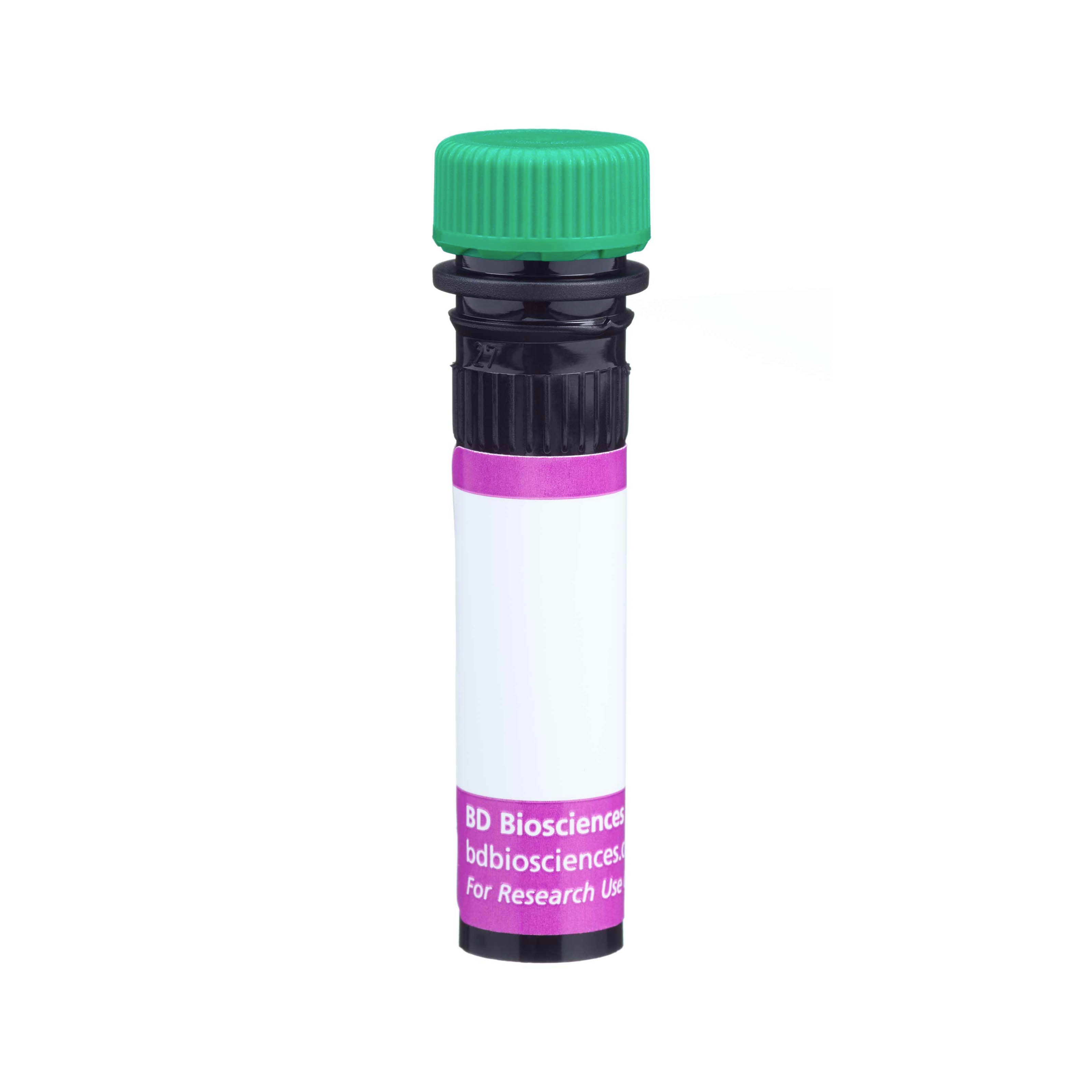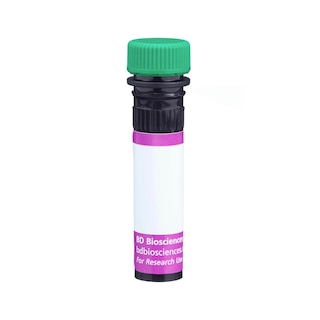Old Browser
Looks like you're visiting us from {countryName}.
Would you like to stay on the current country site or be switched to your country?




Multicolor flow cytometric analysis of CD23 expression on BALB/c mouse splenocytes. Splenic leucocytes were stained simultaneously with PE anti-Mouse IgM[a] antibody (Cat. No. 553517) and with either BD Horizon™ BV510 Rat IgG2a, κ Isotype Control (Cat. No. 562952; Left Panel) or BD Horizon™ BV510 Rat anti-Mouse CD23 antibody (Cat. No. 563200; Right Panel). Two-color flow cytometric dot plots show the correlated expression patterns of CD23 (or Ig Isotype control staining) versus IgM for gated events with the forward and side light-scatter characteristics of viable splenic leucocytes. Flow cytometric analysis was performed using a BD LSRFortessa™ Cell Analyzer System


BD Horizon™ BV510 Rat Anti-Mouse CD23

Regulatory Status Legend
Any use of products other than the permitted use without the express written authorization of Becton, Dickinson and Company is strictly prohibited.
Preparation And Storage
Product Notices
- Since applications vary, each investigator should titrate the reagent to obtain optimal results.
- Source of all serum proteins is from USDA inspected abattoirs located in the United States.
- An isotype control should be used at the same concentration as the antibody of interest.
- Please refer to www.bdbiosciences.com/us/s/resources for technical protocols.
- Caution: Sodium azide yields highly toxic hydrazoic acid under acidic conditions. Dilute azide compounds in running water before discarding to avoid accumulation of potentially explosive deposits in plumbing.
- For fluorochrome spectra and suitable instrument settings, please refer to our Multicolor Flow Cytometry web page at www.bdbiosciences.com/colors.
- Brilliant Violet™ 510 is a trademark of Sirigen.
Companion Products



.png?imwidth=320)
The B3B4 monoclonal antibody specifically binds to CD23, the low affinity IgE Fc receptor (FcεRII) expressed on mature resting conventional B lymphocytes, but not on B-1 cells (CD5+ B cells) or T lymphocytes. It does not react with high-affinity IgE receptors, as demonstrated on mouse mast cell lines. The regulation of CD23 surface expression on activated B cells appears to be complex, depending upon the mode of activation and the presence of cytokines. IgE synthesis is negatively regulated by CD23, and CD23 expression is upregulated on splenocytes in the presence of IgE. CD23 is also upregulated on follicular dendritic cells in the lymph nodes of immunized mice, and a subset of splenic dendritic cells expresses CD23. The B3B4 antibody abrogates antigen-specific IgE-dependent modulation of immune responses in normal mice. This monoclonal antibody also blocks IgE binding and eosinophil infiltration in the lung of immunized mice. Different in vivo results have been obtained when using the intact B3B4 antibody or the F(ab')2 fragments. B3B4 mAb does not cross-react with rat or human IgE Fc Receptor.
The antibody was conjugated to BD Horizon™ BV510 which is part of the BD Horizon™ Brilliant Violet™ family of dyes. With an Ex Max of 405-nm and Em Max at 510-nm, BD Horizon™ BV510 can be excited by the violet laser and detected in the BD Horizon™ V500 (525/50-nm) filter set. BD Horizon™ BV510 conjugates are useful for the detection of dim markers off the violet laser.

Development References (14)
-
Conrad DH, Waldschmidt TJ, Lee WT, et al. Effect of B cell stimulatory factor-1 (interleukin 4) on Fc epsilon and Fc gamma receptor expression on murine B lymphocytes and B cell lines. J Immunol. 1987; 139(7):2290-2296. (Clone-specific: Flow cytometry, Functional assay, Immunoaffinity chromatography, Immunoprecipitation, Radioimmunoassay). View Reference
-
Coyle AJ, Wagner K, Bertrand C, Tsuyuki S, Bews J, Heusser C. Central role of immunoglobulin (Ig) E in the induction of lung eosinophil infiltration and T helper 2 cell cytokine production: inhibition by a non-anaphylactogenic anti-IgE antibody. J Exp Med. 1996; 183(4):1303-1310. (Clone-specific: Blocking). View Reference
-
Dasic G, Juillard P, Graber P, et al. Critical role of CD23 in allergen-induced bronchoconstriction in a murine model of allergic asthma. Eur J Immunol. 1999; 29(9):2957-2967. (Clone-specific: Blocking, In vivo exacerbation). View Reference
-
Kisselgof AB, Oettgen HC. The expression of murine B cell CD23, in vivo, is regulated by its ligand, IgE. Int Immunol. 1998; 10(9):1377-1384. (Clone-specific: Flow cytometry). View Reference
-
Maeda K, Burton GF, Padgett DA, et al. Murine follicular dendritic cells and low affinity Fc receptors for IgE (Fc epsilon RII). J Immunol. 1992; 148(8):2340-2347. (Clone-specific: Electron microscopy, Immunohistochemistry). View Reference
-
Oshiba A, Hamelmann E, Haczku A, et al. Modulation of antigen-induced B and T cell responses by antigen-specific IgE antibodies. J Immunol. 1997; 159(8):4056-4063. (Clone-specific: Blocking). View Reference
-
Pulendran B, Lingappa J, Kennedy MK, et al. Developmental pathways of dendritic cells in vivo: distinct function, phenotype, and localization of dendritic cell subsets in FLT3 ligand-treated mice. J Immunol. 1997; 159(5):2222-2231. (Clone-specific: Flow cytometry). View Reference
-
Rabin E, Cong YZ, Wortis HH. Loss of CD23 is a consequence of B-cell activation. Implications for the analysis of B-cell lineages. Ann N Y Acad Sci. 1992; 651:130-142. (Clone-specific: Flow cytometry). View Reference
-
Rao M, Lee WT, Conrad DH. Characterization of a monoclonal antibody directed against the murine B lymphocyte receptor for IgE. J Immunol. 1987; 138(6):1845-1851. (Immunogen: Blocking, Immunoprecipitation, Inhibition, Radioimmunoassay). View Reference
-
Stief A, Texido G, Sansig G, et al. Mice deficient in CD23 reveal its modulatory role in IgE production but no role in T and B cell development. J Immunol. 1994; 152(7):3378-3390. (Clone-specific: Flow cytometry, Immunohistochemistry). View Reference
-
Waldschmidt T, Snapp K, Foy T, Tygrett L, Carpenter C. B-cell subsets defined by the Fc epsilon R. Ann N Y Acad Sci. 1992; 651:84-98. (Biology). View Reference
-
Waldschmidt TJ, Conrad DH, Lynch RG. Expression of B cell surface receptors. II. IL-4 can accelerate the developmental expression of the murine B cell IgE Fc receptor. J Immunol. 1989; 143(9):2820-2827. (Clone-specific: Flow cytometry, Immunoaffinity chromatography). View Reference
-
Waldschmidt TJ, Conrad DH, Lynch RG. The expression of B cell surface receptors. I. The ontogeny and distribution of the murine B cell IgE Fc receptor. J Immunol. 1988; 140(7):2148-2154. (Clone-specific: Flow cytometry). View Reference
-
Yu P, Kosco-Vilbois M, Richards M, Kohler G, Lamers MC. Negative feedback regulation of IgE synthesis by murine CD23. Nature. 1994; 369(6483):753-756. (Biology). View Reference
Please refer to Support Documents for Quality Certificates
Global - Refer to manufacturer's instructions for use and related User Manuals and Technical data sheets before using this products as described
Comparisons, where applicable, are made against older BD Technology, manual methods or are general performance claims. Comparisons are not made against non-BD technologies, unless otherwise noted.
For Research Use Only. Not for use in diagnostic or therapeutic procedures.
Report a Site Issue
This form is intended to help us improve our website experience. For other support, please visit our Contact Us page.